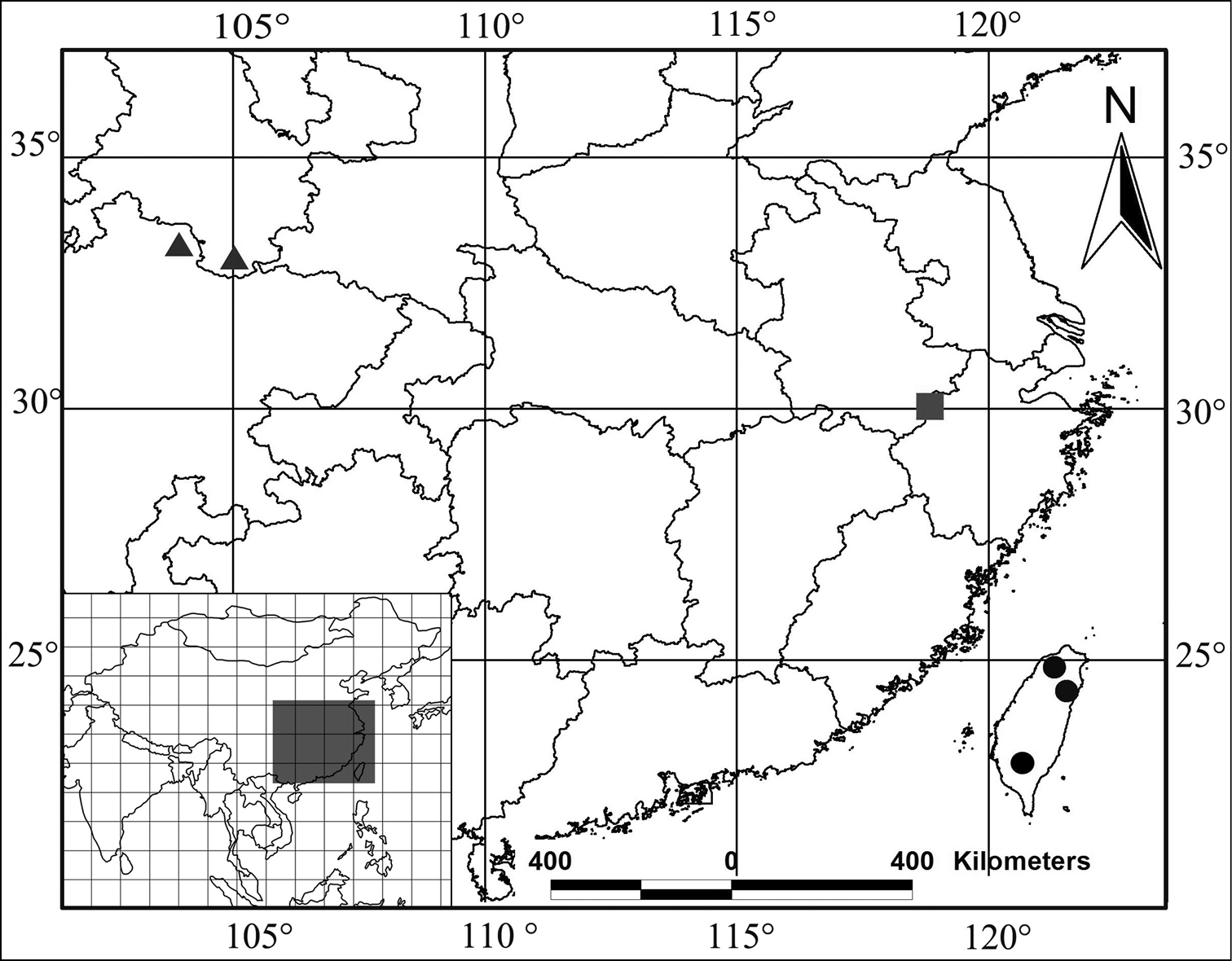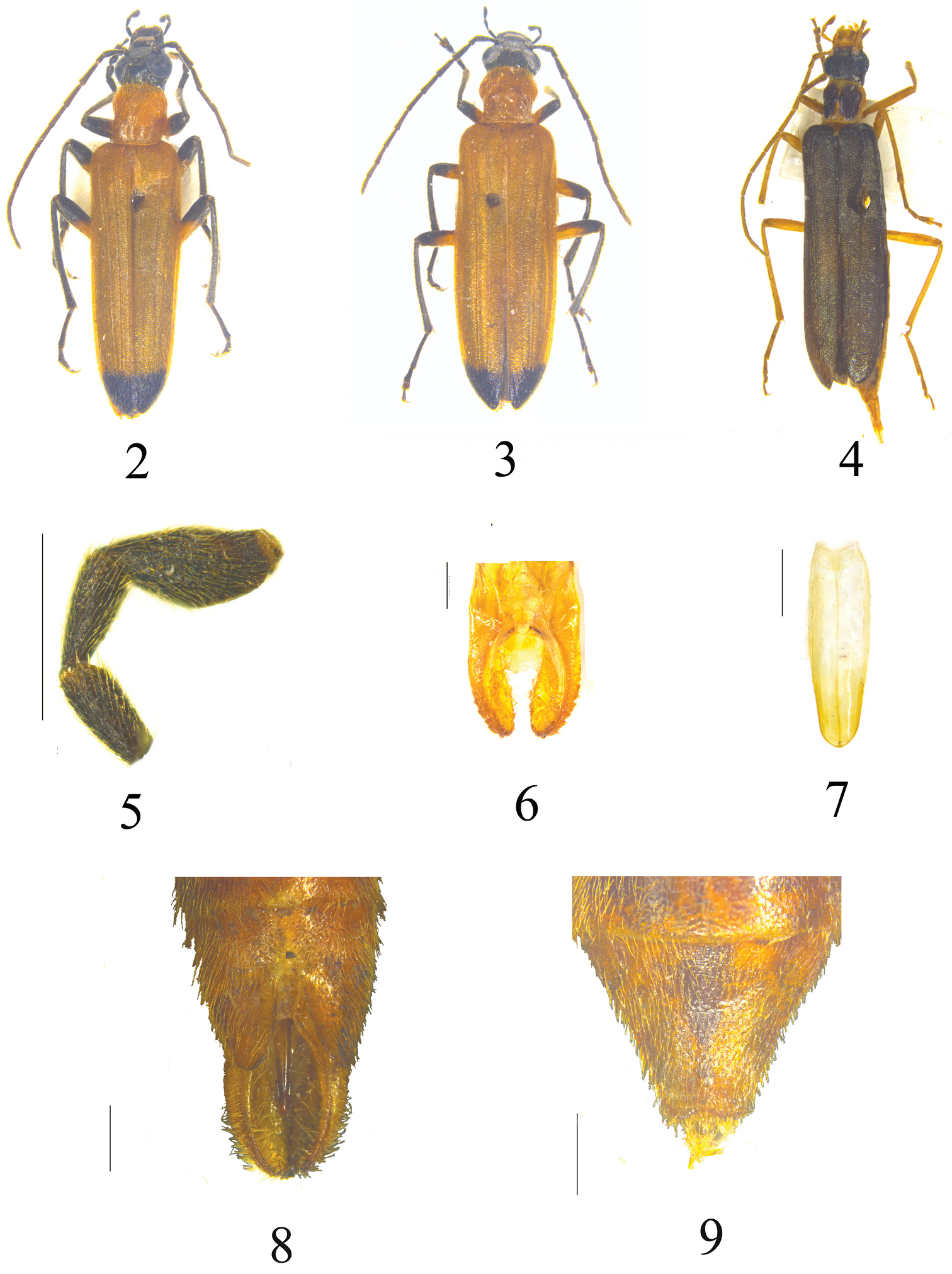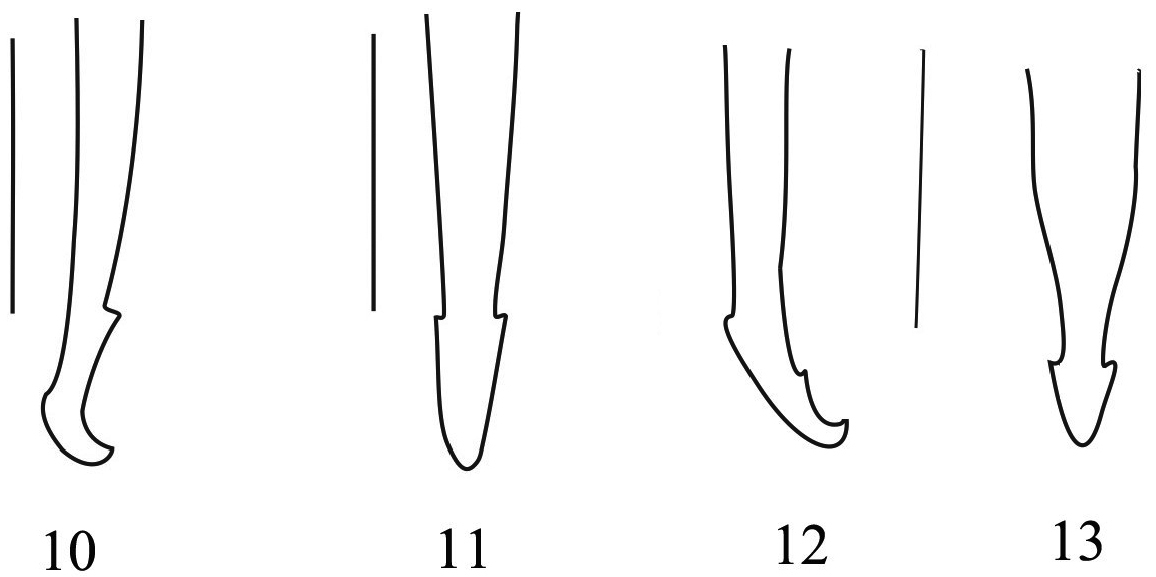






Citation: Tian Y, Ren G-D, Li Q (2014) Taxonomy of the Nacerdes (Xanthochroa) carniolica species-group from China (Coleoptera, Oedemeridae, Nacerdini). ZooKeys 426: 111–118. doi: 10.3897/zookeys.426.7449
This paper deals with a species-group carniolica of the genus Nacerdes from China. This species-group has seven known species/subspecies in the world and two of them are known from China. Nacerdes (Xanthochroa) arcuata sp. n. is a new species belonging to carniolica group. The species were collected from Anhui (Eastern China, 30°02'17.37"N, 118°50'1.72"E). A key to the species of the species-group from China is given along with a distribution map.
Coleoptera, Oedemeridae, Nacerdes, taxonomy, new species, China
The genus Nacerdes was erected by
Distribution of the Nacerdes (Xanthochroa) carniolica species-group from China. ● Nacerdes (Xanthochroa) hiromichii Švihla, 2004 ▲ Nacerdes (Xanthochroa) potanini Ganglbauer, 1890 ■ Nacerdes (Xanthochroa) arcuata sp. n.
The beetles were collected by light trap from Anhui province, Eastern China region. Located across the basins of the Yangtze River and the Huai River, it borders Jiangsu to the east, Zhejiang to the southeast, Jiangxi to the south, Hubei to the southwest, Henan to the northwest, and Shandong for a tiny section in the north.
The collected specimens were identified based on a reference collection and key for species published by
The specimens were examined and described using a Nikon (SMZ800) dissecting microscope. Examinations of aedeagus were carried out. The aedeagus was dissected under a stereoscopic microscope, cleared in 5% NaOH solution for eight minutes under water bath, then placed in a droplet of glycerol and examined under a compound light microscope. The measurements and photographs were carried out under a Leica (M205 A) dissecting microscope. A distribution map was prepared using the geographic information system software ARCVIEW GIS 3.2, based on the authors’ database of the specimens examined for this study and those mentioned in the literature. Body length is measured from the anterior margin of the clypeus to the elytral apex, body width is measured across the humeral part of elytra. All measurements are in millimeters.
The terminology used in this paper largely follows
The holotype and paratypes are deposited in MHBU – Museum of Hebei University, Baoding, China.
Diagnosis. Apicale of aedeagus with recurrent angles, so that it is arrow-shaped in dorsal view.
Distribution. China (Anhui, Sichuan, Gansu, Taiwan), Northern Vietnam, Europe.
(Adapted from
| 1 | Apex of elytra black | 2 |
| – | Elytra brown with slight metallic green tinge | Nacerdes (Xanthochroa) potanini |
| 2 | Aedeagal apicale short, lateral view as in Fig. 12, abruptly narrowed apically in dorsal view (Fig. 13) | Nacerdes (Xanthochroa) hiromichii |
| – | Aedeagal apicale elongate, lateral view as in Fig. 10, gradually narrowed apically in dorsal view (Fig. 11) | Nacerdes (Xanthochroa) arcuata sp. n. |
http://zoobank.org/0DB5A33D-0E46-4DE4-A339-4A529FDBF566
Holotype: male (MHBU): China, Anhui Province, She County, Qingliangfeng N. R., alt. 320 m, 30°02'17.37"N, 118°50'1.72"E, 5–9.vi. 2013, Ji-Shan Xu & Cai-Xia Yuan leg. Paratypes: 2 ♂♂, 8 ♀♀ (MHBU), same data as holotype.
This new species belongs to the Nacerdes (Xanthochroa) carniolica species-group as defined by
The specific name is derived from the Latin adjective arcuatus, meaning arched, referring to the characteristic shape of aedeagus in this species.
Body length 10.3−12.7 mm, body width 2.1−2.7 mm. Head black, maxillary palpi sepia to black. Antennae black, antennomeres gradually lightening to sepia. Basal 2/3 of femora saffron yellow, terminal portion of femora, tibiae and tarsi sepia to black. Pronotum, abdomen and elytra saffron yellow to terra-cotta, apex of each elytron black with dark blue metallic tinge.
Male (Fig. 2). Eyes large, protruding, head across eyes slightly wider than pronotum, frons between eyes 1.8 times as wide as length of antennomere II. Maxillary palp as in Fig. 5. Antennae slightly exceed 1/2 of elytral length, antennomere I more than twice as long as antennomere II, as long as antennomere III, dorsal surface of head and pronotum finely and sparsely punctate and yellow pubescence. Pronotum moderately longer than wide, slightly cordiform, both anterior and posterior pronotal depressions slightly to moderately developed, anterior margin straight, anterior corners rounded, lateral margins moderately sinuate, posterior corners obtuse, posterior margin moderately straight. Elytra nearly parallel-sided, matt, only their dark blue apex lustrous, elytra about four times longer than wide, elytral nervation developed. Both pygidium and last sternite subtriangular, pygidium rounded apically, last sternite incised to 2/3 of its length as in Fig. 8, projections of urite VIII as in Fig. 6. Tegmen (Fig. 7) slightly longer than half of aedeagus, aedeagal apicale as in Figs 10–11.
Nacerdes (Xanthochroa) arcuata sp. n. (2–3, 5–9) and Nacerdes (Xanthochroa) potanini (4). 2 Habitus, male 3 Habitus, female 4 Habitus, female 5 Maxillary palp 6 Projections of urite VIII 7 Tegmen in dorsal view 8 Last sternite, male 9 Last sternite, female. Scale bars = 0.5 mm.
Aedeagal apicale. 10 Nacerdes (Xanthochroa) arcuata sp. n. in lateral view 11 Nacerdes (Xanthochroa) arcuata sp. n. in dorsal view 12 Nacerdes (Xanthochroa) hiromichii in lateral view 13 Nacerdes (Xanthochroa) hiromichii in dorsal view; (Figures 12–13 from
Female (Fig. 3). Head across eyes as wide as pronotum, frons between eyes twice as wide as length of antennomere II, antennae almost reach elytral midlength, pronotum as long as wide, last abdominal segments as in Fig. 9.
China: Anhui.
China: Taiwan.
1♀ (MHBU): China, Gansu, Wen County, Huangtuling, alt. 1, 505 m, 33°00'14.85"N, 105°00'41.55"E, 8.vii.2003, Yi-Bin Ba & Yang Yu leg.; 4 ♀♀ (MHBU): China, Sichuan, Jiuzhaigou, alt. 2, 457 m, 33°15'35.46"N, 103°55'06.40"E, 7–15.viii.2002, Ming Bai & Jian-Feng Wang leg.
China: Sichuan, Gansu.
We would like to express our sincere thanks to Dr. Mohamed Shebl (Faculty of Agriculture, Suez Canal University), Mrs. Cai-Xia Yuan and Mrs. Shan-Shan Liu (College of Life Sciences, Hebei University) for comments on the manuscript, and many thanks are also due to Dr. Yi-Bin Ba (Museum of Hebei University) and Dr. Zhao Pan (Roma Tre University) for kindly help to search literature. The research was supported by the National Natural Science Foundation of China (No. 31272341) and the Foundation of Key Invertebrate Systematics Laboratory in Hebei Province (201309).


